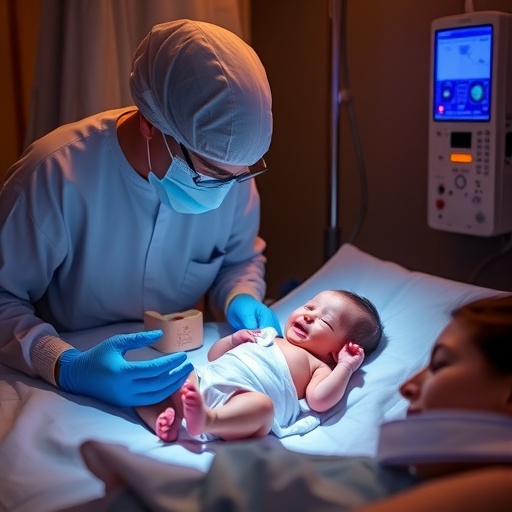In the realm of neonatal care, the management of jaundice in extremely preterm infants remains a critical challenge, with phototherapy serving as a cornerstone therapeutic intervention. A groundbreaking study published in the Journal of Perinatology has recently shed light on the variability of phototherapy exposure resulting from the use of different treatment protocols and devices across neonatal intensive care units. This pioneering research offers an unprecedented cross-sectional analysis that may fundamentally alter how clinicians approach phototherapy dosing in the most vulnerable neonatal populations.
This inquiry centers on extremely preterm neonates, a demographic defined by birth prior to 28 weeks of gestation, who experience disproportionate risks of bilirubin-induced neurotoxicity. Phototherapy, which involves exposure to specific wavelengths of light to facilitate bilirubin breakdown, is indispensable in jaundice treatment; however, its application remains far from standardized. The study elucidates how differing protocols and varied device technologies lead to substantial heterogeneity in the delivered phototherapy doses, with significant clinical implications.
Detailed measurements were systematically obtained from multiple neonatal care centers employing distinct phototherapy devices, including LED-based systems, fluorescent lamps, and hybrid technologies. The authors meticulously quantified irradiance—the power of light delivered per unit area—as a proxy for therapeutic exposure, revealing that irradiance levels can fluctuate dramatically depending on the equipment and protocol choices. Such disparities suggest that some infants may receive suboptimal exposure, potentially prolonging hyperbilirubinemia, while others might be subjected to unnecessary excess, raising concerns about possible phototherapy-associated side effects.
The diversity in treatment techniques is further amplified by institutional protocols, which vary in timing, duration, and intensity of phototherapy administration. Some NICUs adopt aggressive strategies initiating phototherapy at lower bilirubin thresholds and maintaining prolonged exposure periods, whereas others employ more conservative regimens. The researchers’ data demonstrate how such protocol discrepancies translate directly into varied cumulative light doses, indicating a pressing need for harmonization to optimize outcomes.
Technological innovation, while offering advanced features such as better wavelength specificity and improved energy efficiency, also introduces complexity in standardization. LED devices, increasingly prevalent for their lower heat generation and enhanced spectral profiles centered around the 460 nm peak absorption of bilirubin, still exhibit marked differences in light output based on manufacturer and model. This inconsistency complicates the ability of clinicians to precisely control phototherapy dosing without rigorous calibration and monitoring.
Beyond irradiance, geometric factors like distance from the light source, infant positioning, and device coverage impact effective light delivery. The study shows that even small variations in these parameters substantially affect the irradiance reaching the infant’s skin, underscoring the multifaceted nature of phototherapy administration. This highlights the necessity for comprehensive training and protocol design that encompass not only device selection but also meticulous attention to setup and ongoing monitoring.
Moreover, the study highlights the physiological vulnerability of extremely preterm infants to both bilirubin toxicity and phototherapy-induced stress. Overexposure to phototherapy has been linked to complications such as temperature instability, dehydration, retinal damage, and potential interference with circadian rhythms. Conversely, underexposure risks insufficient bilirubin breakdown leading to kernicterus. Therefore, achieving an optimal balance in phototherapy exposure tailored to each neonate’s condition is paramount.
This research also draws attention to the current lack of universally accepted guidelines defining ideal phototherapy dosimetry, especially in the context of evolving device technologies. Existing recommendations often rely on irradiance thresholds established decades ago, primarily from studies involving more mature infants. The findings from this study call for updated, evidence-based standards that account for the specific needs and responses of extremely preterm neonates.
The methodological rigor of the study lies in its cross-sectional design involving multiple centers, each utilizing different clinical protocols and devices, thereby capturing real-world variability rather than experimental conditions. Comparative data analysis allowed the authors to dissect contributions from device type, protocol differences, and operational practices, offering a holistic perspective rarely seen in previous literature. This makes the findings highly relevant for policy makers and clinical stakeholders.
Future research directions inspired by this work include longitudinal studies assessing the neurodevelopmental and systemic impacts of varied phototherapy exposure in preterm infants. Additionally, the development of smart phototherapy devices capable of real-time irradiance measurement and automated dose adjustments could revolutionize individualized treatments, mitigating risks associated with variability.
The urgency of this research is amplified by the global burden of neonatal jaundice, particularly in resource-limited settings where device standardization is challenging and protocol variability may be even more pronounced. Insights gained here underscore the importance of international collaboration to establish best practices and ensure equitable standards of care for the most fragile newborns worldwide.
In summary, this study by De Luca and colleagues represents a milestone in neonatal phototherapy research, revealing how variable treatment protocols and device technologies contribute to inconsistent phototherapy exposure in extremely preterm infants. Their findings advocate for the harmonization of clinical practices and implementation of advanced device calibration protocols to safeguard optimal therapeutic efficacy while minimizing adverse effects.
The study’s impact extends beyond neonatology, opening avenues for multidisciplinary innovation in biomedical engineering, clinical guidelines formulation, and healthcare policy development. It reminds the scientific community of the nuanced complexity inherent in translating a well-established therapy into safe and effective application for the most delicate patients.
As the neonatal care landscape continues to evolve, integrating precision medicine principles with sophisticated device engineering will be essential. This research not only highlights present challenges but also ignites hope for cutting-edge solutions that ensure phototherapy’s lifesaving benefits are delivered consistently and safely to all extremely preterm neonates.
Subject of Research: Phototherapy exposure variability in extremely preterm neonates due to different treatment protocols and devices.
Article Title: Phototherapy exposure variability in extremely preterm neonates due to different treatment protocols and devices: cross-sectional study.
Article References:
De Luca, D., Neri, C., Monin, V. et al. Phototherapy exposure variability in extremely preterm neonates due to different treatment protocols and devices: cross-sectional study. J Perinatol (2025). https://doi.org/10.1038/s41372-025-02484-x
Image Credits: AI Generated
DOI: 10.1038/s41372-025-02484-x (Published: 05 November 2025)




